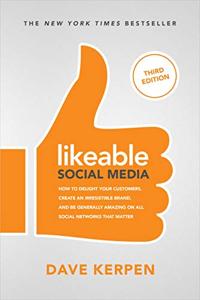
Want to learn the ideas in Likeable Social Media better than ever? Read the world’s #1 book summary of Likeable Social Media by Dave Kerpen here.
Read a brief 1-Page Summary or watch video summaries curated by our expert team. Note: this book guide is not affiliated with or endorsed by the publisher or author, and we always encourage you to purchase and read the full book.
Video Summaries of Likeable Social Media
We’ve scoured the Internet for the very best videos on Likeable Social Media, from high-quality videos summaries to interviews or commentary by Dave Kerpen.
1-Page Summary of Likeable Social Media
A Graceful, Savvy Tweet
In 2010, Dave Kerpen was tired and frustrated after a six-hour flight. He tweeted on his BlackBerry that no hotel in Las Vegas could be worth the wait he faced at the Aria Hotel. The Rio Hotel responded with an apology instead of telling him to leave.
When Kerpen returned to Las Vegas, he stayed at the Rio Hotel. He used Facebook’s Like button to tell his friends that he approved of the hotel. Later, a friend asked Kerpen for a recommendation and he suggested the Rio Hotel. The influence of online social networks is amazing because one tweet resulted in thousands of dollars in new business for the hotel as well as other benefits from people who are influenced by what they see on their friends’ Facebook pages.
The Powerful Like Button
In 2010, Facebook introduced the Like button. Since then, more than 600 million people have used it to share content with their friends and family online. This function provides dynamic word-of-mouth marketing for Facebook and other social networks that use this feature.
Social networks have become the most popular way to connect with consumers. This is because traditional media outlets such as TV, radio and newspapers are losing their audiences. Marketers must use social networks in order to reach customers nowadays. The most popular social network sites include Facebook and Twitter. Facebook allows you to create a profile for yourself and add friends who can see your updates or share links with you via e-mail. You can also start groups on any topic or set up fan pages like those for companies, organizations, public figures and celebrities. People who visit your website will be able to “Like” it by clicking a button on your site that takes them directly to your Facebook page where they’ll find more information about what you’re doing there. If you live near an area of interest (such as the beach), you could start a Places page on Facebook so people can come together from all over the world who share common interests.”
Twitter – This online social networking service lets you send short messages called tweets. Each tweet is limited to 140 characters, and you can direct your message at someone by beginning it with the @ symbol followed by their Twitter name (for example, @davekerpen). Use Twitter’s search function to find out what people are talking about online and get insights into consumers who buy products like yours.
You can use web-based video sharing sites to showcase your products and services. Some videos go viral, but that shouldn’t be the goal. Rather, you should work so that your target audience sees them. Foursquare is a location-based social networking tool for mobile users; it lets people know where they are at any given time. Retailers and other firms also use it to extend special offers to customers who visit their locations. LinkedIn is an online electronic Rolodex with more than 100 million businesspeople in its database; it’s ideal for recruiting employees, retaining current ones and collaborating with industry peers as well as connecting with professional colleagues at all levels of the organization. Businesses love using LinkedIn because of its B2B focus and ease of use compared to traditional job boards or internal company websites for recruitment purposes. Blogs are another way to communicate ideas about your business on the Internet; set one up if you want to show off your expertise in a particular field (such as photography) or niche market (for example, music). The blogosphere has 150 million blogs currently in existence on the internet ; update yours regularly so that readers will come back often. Specialized social networks like Flickr are geared toward photographers while MySpace caters towards music lovers; there are hundreds more specialized social networks available online, including Affluence (for rich people) and Dogster (for dog lovers). Angie’s List, TripAdvisor, Yelp! – these review style social network sites offer niche services enabling companies to communicate specifically with highly targeted consumer groups.





